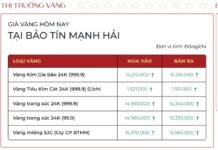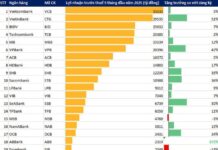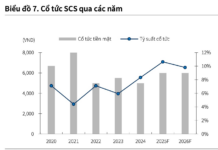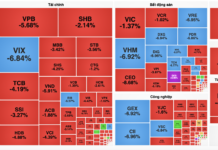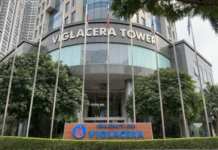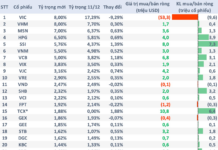
Vietnam’s Logistics Performance Index (LPI) in 2023 ranked 43rd out of 154 countries and territories (according to the World Bank) and was among the top 5 in the ASEAN region. – Photo: Internet |
At the Vietnam Logistics Forum 2024, themed “Free Trade Zones – Breakthrough Solutions to Boost Logistics Growth,” co-organized by the Ministry of Industry and Trade and the People’s Committee of Ba Ria-Vung Tau province on December 2, Mr. Tran Thanh Hai, Deputy Director of the Import-Export Department (Ministry of Industry and Trade), shared that with the attention of the Party and State and the unity of logistics enterprises, Vietnam’s logistics services have achieved remarkable results, as reflected in the following figures:
Vietnam’s LPI in 2023 ranked 43rd out of 154 countries and territories, according to the World Bank.
Vietnam’s Logistics Performance Index (LPI) in 2023 ranked 43rd out of 154 countries and territories (according to the World Bank) and was among the top 5 in the ASEAN region; ranked 10th out of 50 emerging logistics markets; the logistics industry’s growth rate in Vietnam in recent years reached about 14-16%, with a scale of about 40-42 billion USD/year.
In terms of infrastructure, Vietnam’s logistics infrastructure includes road infrastructure, with 61-64% of goods transported by road; 3,143 km of railway network and 277 stations, a railway density of 9.5 km/1,000 km2, reaching the ASEAN and world average, and ranked 58th out of 141 countries in terms of network density. Vietnam has more than 17,000 km of inland waterways in operation; 310 ports, 6,274 inland waterway wharves, and 18 ports capable of receiving vessels of over 3,000 tons, including 20 ports that can receive foreign vessels.
With its maritime transport system, Vietnam has 286 port terminals belonging to 5 coastal regions, with a total quay length of about 100 km; 2 special seaports capable of receiving container ships of up to 132,000 DWT at Lạch Huyện and 214,000 DWT at Cái Mép; 1,477 vessels with a total capacity of 11.6 million DWT, ranking 2nd in ASEAN and 22nd in the world; and 32 routes, including 25 international routes and 7 domestic routes. Currently, Vietnam has 22 operational airports. There are 69 large and medium-sized logistics centers, concentrated in some industrial zones.
Regarding logistics service enterprises, there are currently 46,428 transport and warehouse enterprises; 5,000 enterprises providing 3PL (third-party logistics) services;…
Affirming that logistics paves the way for trade and production, Mr. Tran Thanh Hai said that the scale of Vietnam’s logistics services is evident in the double-digit growth in the volume of goods transported and circulated in the first nine months of 2024 and over the years. Logistics promotes regional connectivity, and the scale of Vietnam’s warehouse market has reached 4 million square meters, with a growth rate of 23% per year in the period of 2020-2023. These warehouses are concentrated in key economic regions.
Green Logistics Trend
According to Mr. Tran Thanh Hai, after the fluctuations in the supply chain in the world market, there have also been changes in the logistics industry, specifically: The trend of shifting the supply chain out of China or adding another location outside of China to diversify production bases; the trend of seeking markets closer to consumption sources; and the trend of green supply chains reflected in transportation, warehousing, and packaging activities.
“The logistics industry is one of the top three industries with high emissions, along with industrial production and energy. Among them, the transport sector accounts for the largest proportion of emissions as road, waterway, and air transport vehicles consume a lot of energy. Therefore, the green logistics trend first manifests in the transition to less emission-intensive energy sources, the use of energy-saving methods, and improved transport efficiency,” said Mr. Tran Thanh Hai.
The trend of technology application and automation is also taking place rapidly and strongly. E-commerce is currently the main direction, and logistics in e-commerce cannot help but apply technology.
Developing Logistics into a High-Value-Added Service Industry
Based on the current situation and development trends of the logistics service industry, the Ministry of Industry and Trade has been assigned by the Government to develop the Draft Strategy for the Development of Vietnam’s Logistics Services Industry for the period of 2025-2035, with a vision towards 2045 (the Draft Strategy) to promote the comprehensive and synchronous development of the logistics industry, commensurate with Vietnam’s economic development potential in the coming period.
The strategy sets the following targets for 2035: an industry growth rate of 8-12%; 80% of logistics enterprises to digitalize; 70% of the workforce to be professionally trained; 70-80% outsourcing rate; logistics costs/GDP to account for 12-15% (currently 16-18%); and an LPI ranking of over 40.
To develop logistics into a high-value-added service industry, Mr. Tran Thanh Hai emphasized the following key issues:
First, the early formation of a transshipment port will help take advantage of geopolitical advantages and increase the volume of goods for logistics services.
Second, building a national fleet. Currently, we have a large fleet of vessels, but with small tonnage, and many shipowners, so the container ship fleet is still dispersed and fragmented.
Third, establishing free trade zones. In the future, when the Government amends Decree No. 35/2022/ND-CP on the management of industrial parks and economic zones and adds the content related to free trade zones, this will open up opportunities for the development of free trade zones.
Fourth, constructing large, modern, intelligent, automated, and green logistics centers.
Launch of Vietnam Logistics Report 2024
In accordance with Decision No. 200/QD-TTg dated February 14, 2017, of the Prime Minister approving the Plan of Action to improve the competitiveness and development of Vietnam’s logistics services by 2025 and Decision No. 221/QD-TTg dated February 22, 2021, amending and supplementing Decision No. 200, the Ministry of Industry and Trade has been working with logistics experts since 2017 to compile the annual Vietnam Logistics Report to review and assess the situation, prospects, and related policies of Vietnam’s and international logistics… to serve the state management, production, business, and investment activities of enterprises, scientific research, and communications in the field of logistics.
A highlight of the logistics industry in 2024 is the continued attention to investing in and developing logistics infrastructure towards modernity and safety, with many works meeting international standards, and a transport network connecting all regions of the country, helping to reduce logistics costs and delivery time. Many new policies have been issued, and procedures have been adjusted to facilitate enterprises; information, propaganda, research, promotion, and international cooperation activities on logistics have been vibrant and widespread at both central and local levels. Environmental friendliness and sustainable development have been given attention at both macro-management and enterprise levels.
In addition to providing information on the development of Vietnam’s logistics services in the past year, the Vietnam Logistics Report 2024, themed “Free Trade Zones,” focuses on analyzing the importance and potential of FTZs for the development of the logistics industry, while providing assessments and recommendations on sustainable development strategies. The report also evaluates successful FTZ development models worldwide, drawing lessons and suggesting appropriate policies for Vietnam in the coming time.
The Vietnam Logistics Report 2024 consists of 7 chapters: Business Environment for Logistics Services; Logistics Infrastructure; Logistics Services; Logistics in Manufacturing and Trading Enterprises; Activities Related to Logistics; Logistics Development in Localities; and Special Topic: Free Trade Zones.
The report is compiled with the participation of experts from ministries, sectors, associations, training and research organizations… based on a reliable and updated information and data system from official sources and practical survey results.
With the publication of the Vietnam Logistics Report 2024 by the Ministry of Industry and Trade, it is hoped that this valuable document will help state management agencies, experts, and enterprises in the industry to gain a comprehensive overview of the past year. From there, they can make plans, orient, and propose solutions for the following years, contributing to the integration of the entire Vietnam Logistics industry into the flow of goods in the era of the nation’s rise.
The Prime Minister’s Fifth Inspection of the Long Thanh Airport Project Site
On December 3rd, Prime Minister Pham Minh Chinh visited Dong Nai to inspect the progress of two key infrastructure projects: the Long Thanh International Airport and the Bien Hoa-Vung Tau Expressway. With a keen eye for detail, the Prime Minister assessed the development of these projects, which are expected to boost economic growth and connectivity in the region.
The Ministry of Industry and Trade Demands Temu to Stop Offering Lucrative Commissions and Incentives to Lure Users into its Business Model.
The Ministry of Industry and Trade has instructed Temu to discontinue any commission-based or incentive programs that encourage users to engage in business activities in Vietnam.






